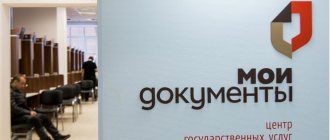The study of the issue was prompted by correspondence with a large family planning to move from Siberia. They asked to see several selected apartments for them - mostly destroyed three-ruble rubles on the first floors of suburban Khrushchev-era apartment buildings with bars on the windows.
Of course, I asked why she is ready to force children to breathe basement fumes, but does not consider Gatchina, where the same budget allows you to buy a decent apartment or even a townhouse with an area of 90 square meters. m with an area where you can plant flowers. I received a bewildered answer: after all, there is a regional registration.
“Okay,” I ask, “what does this change?” I get the standard set of arguments: child benefits are less, I can’t get into school and kindergarten, I can’t get a job in the city... True, the mother of many children explained, her husband is not against the region - but who will ask him. He hopes to work as a taxi driver. And in the Leningrad region both compulsory motor insurance and transport tax are lower...
In general, let's look at the arguments, counterarguments and common myths.
History and price of the issue
Registration at the place of residence (in common parlance – propiska) is an institution that flourished in Soviet times. Without registration it was impossible to get a job, and without work - registration. It turned out to be a vicious circle. To gain a foothold in Moscow or Leningrad, they had to enter into fictitious marriages, get a limited job - for example, as a janitor - or work on high-impact construction sites. Apparently, it was from those years that the dream of registration in a metropolitan metropolis and the fear of losing it live in the genetic memory of Russians.
Now everything is simpler. Registration as such was abolished in 1993, replacing it with registration at the place of residence. Within 90 days after moving, you are required to register. Fictitious marriages and work dorms are a thing of the past. But even those who are seriously limited in funds are willing to overpay for the opportunity to register in St. Petersburg.
Let's estimate how much this amounts to. So, according to BN analysts, a square of secondary housing in St. Petersburg is estimated at 109 thousand rubles, in the Leningrad region - at 57 thousand rubles. True, the Leningrad region is a huge region, so talking about average prices is incorrect.
But there are territories with a comparable level of urban development - the regional Vsevolozhsk and urban Pushkin districts. The first contains the famous St. Petersburg satellites throughout Russia - Murino - Novoye Devyatkino and Kudrovo. In the second, the lion's share of housing market offers is represented by the Shushary, Lensovetovsky and Slavyanka arrays.
The named territories of new regional and urban development have a similar set of social, infrastructural and transport problems. But the average price per square meter on the secondary housing market in the Vsevolozhsk region is 81.8 thousand rubles. (and this is the most expensive regional district), in Pushkinsky - 92 thousand rubles. Thus, under comparable conditions, you have to overpay 10 thousand rubles for the possibility of city registration. per square meter. We looked at the secondary market, but buyers of new buildings are also focused on this or a slightly more significant difference.
Districts of St. Petersburg
In total, there are 18 districts in St. Petersburg, four of them - Pushkinsky, Kolpinsky, Kronstadt and Kurortny - are located in the distance, so they are rarely considered for living. Although housing here is very cheap, so we advise you to take a closer look at them too.
The following districts are considered the center: Central, Admiralteysky, Petrogradsky and Vasileostrovsky. Among the residential areas, the most popular are Moskovsky, Primorsky, Vyborgsky, Frunzensky, Nevsky and Krasnogvardeysky.
The Kirov and Krasnoselsky districts are in slightly less demand. The reason is poor transport accessibility.
The Vyborgsky district of St. Petersburg is considered the most comfortable for living, and the Petrogradsky district is the most prestigious
The most affordable areas for living are Kirovsky, Krasnoselsky, and Nevsky districts. Vyborgsky and Frunzensky are a little more expensive. The most expensive (not counting the center) are Moscow and Primorsky districts.
To more freely navigate the areas of St. Petersburg and know where it is better to live after moving, read our special article.
Leningrad region: territory of cheap housing
The decisive argument in favor of the Leningrad region is, of course, cheap housing. According to realtors specializing in clients from the regions, the majority of those wishing to move to the outskirts of St. Petersburg have amounts of up to 4 million rubles. In the Northern capital, with such a budget you can’t count on spacious and comfortable housing. Thus, according to BN data, currently the average price of an object in the “apartments and studios” segment on the secondary market is 4.3 million rubles, on the primary market – 3.8 million rubles.
Two-room apartment in the price range from 3 million to 4 million rubles. - this is a not-so-new socket in a city sleeping bag, or housing in more or less decent condition, but in suburban areas (Krasnoe Selo, Kolpino, Petergof, Lomonosov).
In the Leningrad region, a wide range of objects fit into the specified budget, among which there are spacious, well-maintained apartments and houses with plots. And in regional centers and settlements outside the 100-kilometer zone, housing prices sometimes seem simply “communist.”
Thus, almost all offers of apartments in Lodeynoye Pole fall into the price range from 1 million to 2 million rubles. And these are not communal rooms: the upper limit is spacious three rubles. With amounts from 1.5 million to 3 million rubles. you can count on an apartment in Priozersk or Vyborg. Subtracting 200-300 thousand rubles from the above values, we get an idea of the prices for similar housing in the surrounding urban-type settlements.
Apartments more expensive than 3 million rubles. in such areas no: no one will buy them. After all, the designated budget allows you to purchase a house with a plot - from the point of view of a resident of a small town, this is better than an apartment.
Arguments against
We have listed the main, but not the only advantages. Now let's talk about the disadvantages of moving to St. Petersburg.
1. St. Petersburg climate and health. Jokes about St. Petersburg are divided into two categories: intelligence taken to the point of absurdity and hopeless dullness (in the literal sense). Alas, this is true. The climate of St. Petersburg is transitional between temperate continental and temperate maritime, and the humidity is very high (on average 94%). In addition, St. Petersburg is also the northernmost city with a million population.
Due to air humidity, the temperature is felt lower (and less tolerated). And if the wind is added to it, the sensations become completely lousy. Summer can come either in June or in August. And it only lasts a week. But you won’t be able to wait for winter, and you’ll also have to send them away until the end of April.
Therefore, it is best to give a person moving to St. Petersburg an umbrella and a raincoat - they will come in handy on the first day!
St. Petersburg has about 75 sunny days a year and high humidity
The number of sunny days per year is about 75. And the minimum duration of a sunny day is less than 6 hours. Lack of sun can lead to vitamin D deficiency, which in turn leads to depression and decreased energy. There is also a risk of vision and dental deterioration. This is especially dangerous for young children who have moved from sunnier regions.
High humidity and winds are the worst enemies of people with pulmonary diseases. If you belong to this category, you will have to be twice as careful about your health as usual.
Those moving should also prepare for a general decrease in immunity. But in general, if you do not have serious chronic diseases, then life in St. Petersburg will not ruin your health. All possible problems can be solved by seasonally taking vitamins and paying attention to health.
2. Everyday life. No matter how beautiful and impressive St. Petersburg is, when people move here for permanent residence, people eventually stop noticing its beauty. And that's okay.
If you came to St. Petersburg for a weekend or vacation and decided to move, being influenced by the charming atmosphere of this city, do not be fooled by the fact that everyday life here will be the same.
The sleeping areas of St. Petersburg are no significantly different from the sleeping areas of Ekaterinburg or Saratov. And renting an apartment in the historical center is very expensive.
The sleeping areas of St. Petersburg are no different from the sleeping areas of other cities | Photo from varlamov.ru
If for a tourist the raising of bridges is an interesting spectacle, then for a St. Petersburg resident it is a serious transport problem. Returning to the previous point, the romance of rainy St. Petersburg very quickly becomes boring, and the frequent changes in weather during the day are tiring.
Theoretically, you always have the opportunity to rush out of town or into the center on the weekend, but in reality, the general spleen that St. Petersburg residents often succumb to can “lock” you at home.
In short, if you are coming for a fairy tale, you definitely won’t stay long. If you are ready to face harsh reality, St. Petersburg is waiting for you.
3. People. More precisely, their number. Firstly, there are large tourist flows that clog the center. People literally walk along Nevsky in droves, at any time of the day or year.
Secondly, the local population, which is growing every year. By the way, St. Petersburg ranks first among Russian cities in terms of the number of internal migrants. This means that people from the regions most often move here.
St. Petersburg is the leader in the number of internal migrants
There is a terrible crush in the metro during rush hours. The lucky ones with cars, of course, will not encounter this problem. But they will be stuck in traffic jams for hours. By the way, you can get stuck in a traffic jam even on Sunday evening.
In St. Petersburg, you definitely won’t be bored alone - it’s not so easy to find him here. But people in St. Petersburg are sincere and responsive!
Getting used to the number of people in St. Petersburg is even more difficult, the smaller the city you are moving from.
4. Fraudsters. Alas, in St. Petersburg you always need to keep your eyes open, because many people want to profit at your expense. Moreover, they focus primarily on visitors.
You risk falling into their clutches already at the stage of searching for housing. Here it’s just a minefield: people who re-let other people’s apartments, real estate agencies that charge for information services, and simply unscrupulous realtors who take advantage of deceptive advertisements.
With work, you can also sit in galoshes. On thematic forums you will find many sad stories. In general, be extremely careful and pay for services upon receipt, and not in advance!
5. Drug addiction and alcoholism. Due to depression from lack of sun, residents can become addicted to alcohol and even drugs. The latter is much more accessible in St. Petersburg than in average Russian cities, so the use of illegal drugs is quite common, and among different segments of the population.
St. Petersburg is one of the ten cities with problems with drugs and alcohol
Simply put, addictions can arise in quite prosperous people. Alas, this is typical for all northern cities.
Labor market and social benefits
In St. Petersburg, maternity capital (in 2021 it amounts to 453 thousand rubles) will not allow you to move from a one-room to a two-room apartment: it can only buy four square meters of living space. In the region, the amount of the benefit will provide a radical improvement in living conditions, and a military mortgage (2.4 million rubles) is a real breakthrough. Social benefits and low housing prices in the Leningrad region make it an attractive place of residence for families with many children, public sector workers, teachers and doctors, military personnel and “northern” pensioners.
At first glance, the apartment market in remote areas is well balanced in terms of price and quality of life. But there is an unpleasant detail. Low prices in local housing markets are a sure sign of unemployment. But high-paying jobs in regional centers are bad. Therefore, residents of nearby areas of the region prefer to look for work in St. Petersburg. As a result, in regional territories that have good connections with the city, real estate prices are very close to city prices.
For reference: the average salary in the Leningrad region (Petrostat data for May) is 42.9 thousand rubles. per month, the highest paying areas are transport and logistics. In St. Petersburg – 47.2 thousand rubles; the industries with the highest salaries include IT, construction and real estate. Unemployment benefits in the city and region are the same: minimum – 850 rubles, maximum – 4.9 thousand rubles. per month.
The official cost of living, from which social benefits are calculated, in the Leningrad region is 9,725 rubles, in St. Petersburg – 10,862 rubles. (data for the first quarter of 2021). In general, a comparison of social payments and benefits shows an advantage in favor of St. Petersburg, although insignificant. The most noticeable difference is regional maternity capital (issued for the third child in the family): in the city - 140 thousand rubles, in the Leningrad region - 117 thousand rubles.
Moving to St. Petersburg: real reviews
We have collected for you reviews of people who moved to St. Petersburg from other cities and even countries! Find out whether it’s good to live in St. Petersburg, first-hand!
Alexandra, 25 years old. Moved to St. Petersburg from Ukraine in 2014
I arrived 4 years ago and initially didn’t plan to stay in St. Petersburg for a long time, but it turned out differently. She adapted quite quickly, despite the fact that she moved from another country. It helped a lot that I’m from a big city, so I didn’t shy away from a big city.
I still have difficulties with the pace of St. Petersburg, I’m used to a faster life. This is especially felt in the metro during rush hour, when the slowness of people literally drives them crazy. Another problem for me is the short daylight hours during the winter season.
Regarding the other popular disadvantages of St. Petersburg, I want to say one thing: the devil is not as terrible as he is painted. There is a lot of work in the city, in a variety of fields. If you are not lazy, you can easily earn money for rented housing, a normal life and entertainment.
The popular theme of rain is also, in my opinion, exaggerated. I don’t always carry an umbrella with me; I usually rely on the weather forecast and my own intuition. In four years I made mistakes literally a couple of times.
In general, you get used to the local climate quickly, despite all the negative reviews about the St. Petersburg winter. The only thing is that you need to strengthen your body with vitamins. If you are moving from the southern regions, be sure to take iodine and monitor your thyroid gland.
Salavat, 30 years old. Moved from Ufa in 2005
Peter is a fake. One big, five-million-dollar crumpled, dusty candy wrapper that looks like it’s about to crumble into dust, but by some miracle it’s been holding on for the fourth century. But if without lyrics, then Peter is a completely ordinary multi-millionaire.
I don't consider St. Petersburg cultural. A city is people, and its culture is made up of the culture of its inhabitants. After 13 years, I can’t understand how cultured people can live for decades, half a century in conditions of hellish communal apartments, without making a single attempt at at least some kind of self-organization and even the slightest repair not only of their personal living space, but also of common areas. But the house is historical, yes, everything in it breathes and smells of history, even the cracks in the ceiling, but especially the elevators. Or clinics. Where else can you feel the spirit of true St. Petersburg culture, if not in the morning line at the clinic reception desk!
But let's get back to history. Absolutely no one knows her, but everyone remembers that she exists and she is very rich, and wealth is nice, it’s interesting, everyone loves wealth. So it turned out that St. Petersburg people love what they don’t know.
Ask someone about St. Petersburg traditions. 99 out of 100 will begin to mumble something about curbs, front doors, rare mention of a chronic runny nose and disdain for everything human. Well, there’s nowhere without Chizhik-Pyzhik, of course.
And so it is with everything in St. Petersburg. Each of his traits has a downside and most often an unpleasant side, but somehow it’s not customary to talk about it or something. Intelligence - hypocrisy, elegant facades - shabby gateways, goodwill - hypocrisy, a window to Europe - turning off hot water for the summer. The list goes on for a long time.
At the end we get a great city with an ordinary regional life and beautiful houses. Those who come here for the first time and stay do not immediately realize the true state of things, but if this does happen, they are no longer able to get out, poisoned by swamp gases, a nasty climate and a hypnotically slow way of life.
Alexey, 29 years old. Moved from Moscow in 2017
I am from the Moscow region, I lived in Moscow for more than five years. Before moving, I came to St. Petersburg several times - to concerts and festivals. I liked the city, and I decided to move to it for permanent residence. As a result, the reviews are as follows:
1. There are five coffee shops on the way from my house to the metro. In Moscow it is difficult to find a place with delicious coffee and good pastries, but in St. Petersburg they are everywhere. By the way, there are also five beer spots along this route. There is generally a developed culture of alcohol here, but without drinking.
2. Public transport is terrible and wonderful at the same time: classic minibuses are a necessary evil if you want to travel along a route where nothing else goes. But if you are lucky enough to be on a tram or metro line, life will be much easier.
3. At first the weather surprises, infuriates, irritates, then acceptance occurs. And I've already reached the stage where I like her.
4. If you move from the Moscow region, you need to support your body with calcium. The dentist explained to me that the local water does not contain fluoride, so calcium is not particularly retained. And you shouldn’t rely heavily on coffee, because it washes out calcium.
5. The water is of very high quality compared to the Moscow region. The water filter can last for six months without even needing to be washed.
6. There are a lot of hypermarkets. With a good location between “Okay”, “Carousel” and “Lenta” you can save a lot of money on various discounts. In the end, I spent less on groceries than in a small town near Moscow.
7. There are enough inadequate personalities. They could just be marginalized people or drug addicts. On the positive side, they are usually non-aggressive. In general, the level of crime in St. Petersburg is low, and most of it is due to drugs.
8. Reasonable rental prices. Due to the large supply on the market, prices are very competitive, at the level of the remote Moscow region. I’m generally silent about Moscow.
9. Everyone is very slow, as if no one is in a hurry. Perhaps, if compared with the outback, it will be wow speed. But in the Moscow region or, for example, Vladimir, the speed of life is much higher.
10. It’s normal here to sit on the open balcony of a residential area and draw on an easel. Or put on an extremely extravagant outfit and go outside - there will be no offensive comments or sidelong glances directed at you. Here everyone is accustomed to something new, strange, and treats it either positively or indifferently.
Communal payments
As for the prices and quality of utilities, the Leningrad region, to put it mildly, does not win in this regard. This is understandable: the budgets of third-level municipalities are not comparable to city ones. Yes, metropolitan residents are forced to pay more for electricity, but this difference is insignificant. The single-rate tariff for apartments with gas stoves in the city from July 2021 is 4.53 rubles/kWh (with electric stoves - 3.40 rubles/kWh), for the region these values are 4.07 and 2, respectively. 97 rub.
Utility tariffs are regulated by the relevant committees of executive authorities. In St. Petersburg they are the same for everyone. But it is more difficult for regional authorities to come to an agreement with local suppliers and curb rising prices for heating and water supply. In particular, residents of territories whose water supply and heating are provided by departmental suppliers are sometimes forced to overpay. Thus, city residents pay for water according to the meter at the rate of 30.09 rubles. per cubic meter m, while in the region water supply tariffs for the population range from 17 to 80 rubles. per cubic meter m. At the same time, the quality of tap water from local suppliers varies greatly.
Social services at the place of residence
Russians still receive most social services at their place of registration. The main part of the “social package” is schools, kindergartens, and outpatient medical care.
Providing places in preschool institutions is the task of local administrations. In St. Petersburg, the process is formalized: residents have the opportunity to get on the waiting list through the MFC or the government services portal. At first, you may be offered a kindergarten at the other end of the area. But there is always a chance that places will become available in the nearest preschool institutions and it will be possible to transfer. In the region it’s more difficult: you have to negotiate with managers and knock on the doorsteps of municipal administrations.
In the suburban areas of St. Petersburg, where mass housing construction has begun in recent years, the situation with social infrastructure, to put it mildly, is not good. Residents of “border” regional areas are constantly faced with the fact that there are not enough kindergartens there, and their children are not accepted into the city ones. And this is really a problem.
Regional registration will not be an obstacle to attaching a compulsory medical insurance policy or getting an appointment with a doctor in a city clinic: medical services under the basic package are provided on an extraterritorial basis. But in “border” areas, incidents of this kind occur: an ambulance arrives at a city house almost immediately, and to a regional house located next door – within forty minutes from the nearest regional center.
How to register in another city temporarily?
How to register in another city?
Every year a huge number of Russian citizens need to obtain temporary registration. This procedure is quite simple and is carried out as follows:
- Come to the passport office of the city where you want to obtain a temporary residence permit.
- Provide the following list of documents to the government agency employees:
- application requesting temporary registration;
- a document proving your identity;
- a statement from the owner of the property confirming his consent to obtain a temporary registration at his address and for you.
- Wait until all documents are processed and receive a certificate of temporary registration at your new place of residence.
Temporary registration is issued for a certain period of time specified in the certificate of its receipt. The validity period of temporary registration cannot exceed 3 years.
If you wish to extend your registration, you can submit a corresponding application to the passport office. If it is approved, it is necessary to repeat the algorithm presented above.
Transport tax, OSAGO
In former times, the region was considered almost an offshore zone for owners of powerful cars. Today everything is almost equal. Owners of 500-horsepower Bentleys and Maybachs both in the city and in the region must pay an annual transport tax at a flat rate of 150 rubles/hp. The preferential rate (16 rubles/hp) in the region is maintained only for small cars up to 100 hp. In St. Petersburg, the owner of such a car will pay tax at the rate of 24 rubles. Thus, the real savings of a regional resident are no more than 400 rubles. in year. St. Petersburg owners of trucks from 200 to 250 hp. will pay 2.0-2.5 thousand rubles. less than regional ones, which is also not a serious argument in favor of city registration.
A significant cost item for a motorist is motor third party liability insurance (MTPL). The regional coefficient in the region is 1.6, in St. Petersburg – 1.8. For a careful driver with extensive experience, the difference is small. But for those who pay the maximum (more than three insurance events for the previous period), it can amount to 10-15 thousand rubles. in year.
Thus, the Leningrad region is comfortable not only for state employees, benefit recipients and pensioners. For “crazy” drivers it is just a resort.
Text: Philip Urban Photo: Alexey Alexandronok








